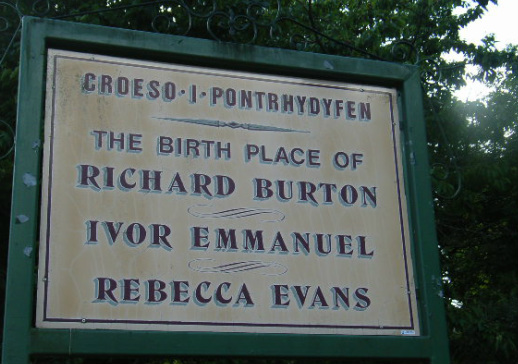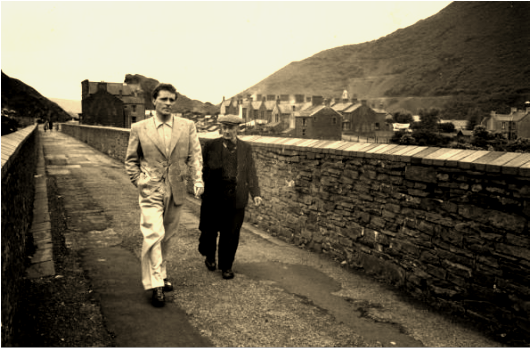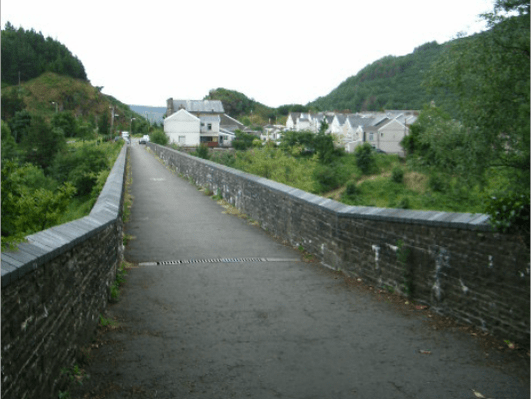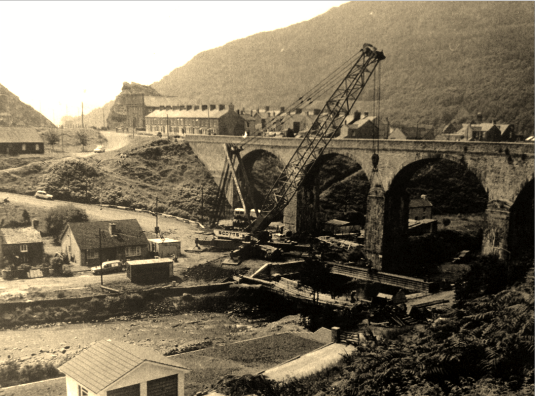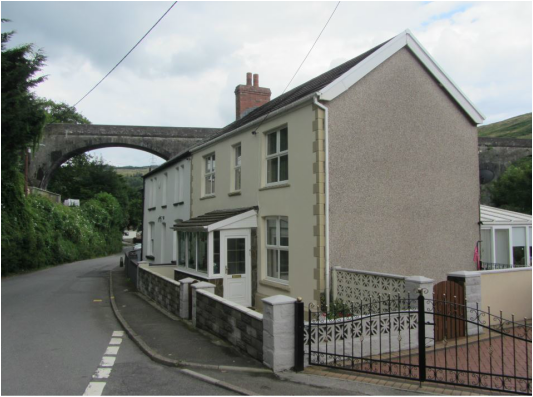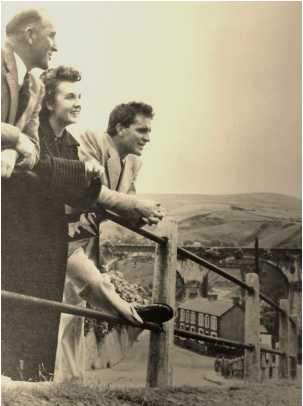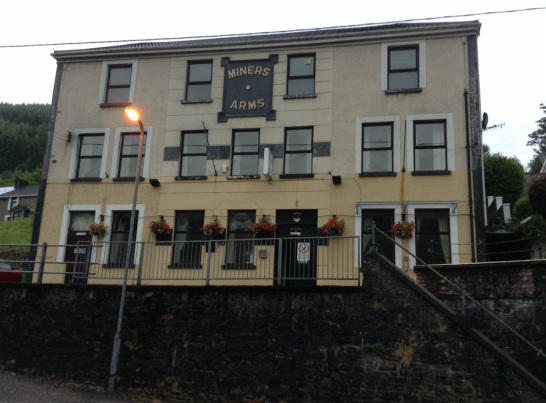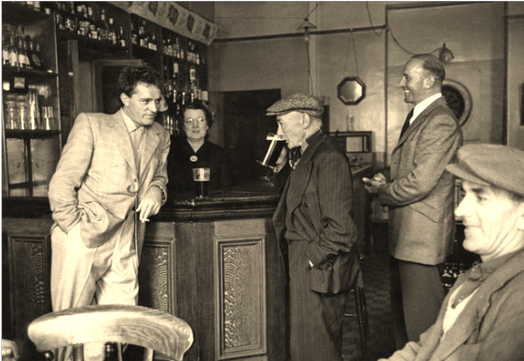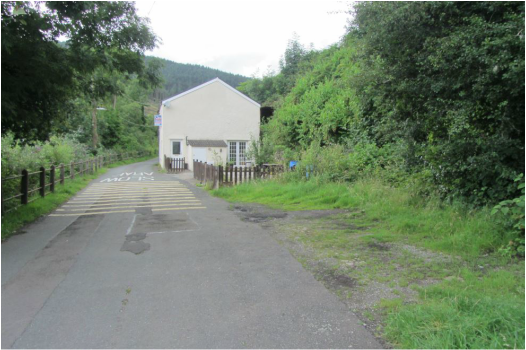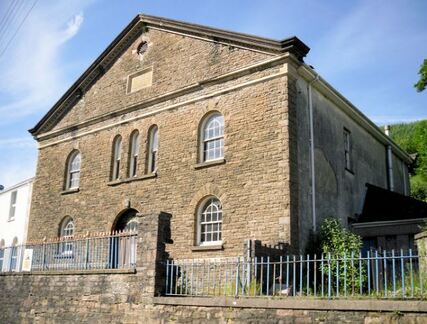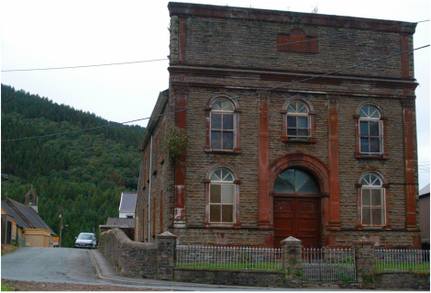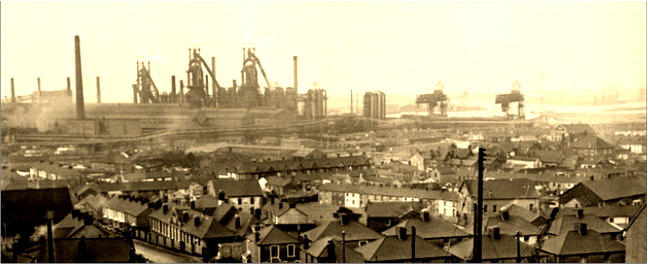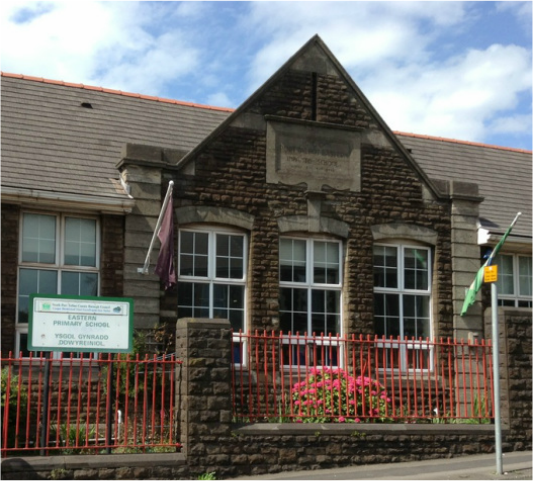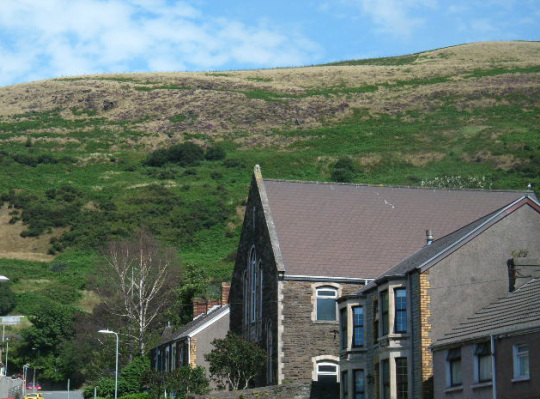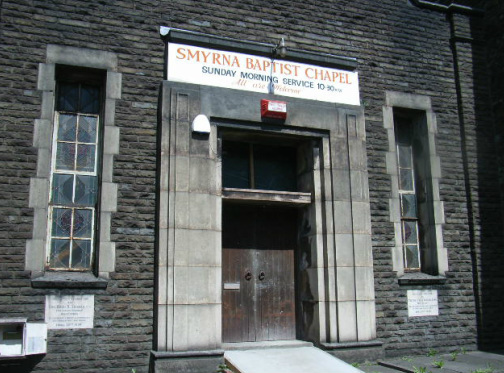Richard Burton's Pontrhydyfen and Port Talbot
"Pontrhydyfen is, stick for stick and stone for stone, blade of grass for blade of grass, virtually the same, exactly as it was when I was a child."
Richard Burton in conversation with Vincent Kane, B.B.C. Wales Cymru, February, 1977
Richard Burton in conversation with Vincent Kane, B.B.C. Wales Cymru, February, 1977
Nestled deep in the heart of the beautiful Afan Valley, approximately ten miles from Swansea and just four miles from Port Talbot, is the small picturesque village of Pontrhydyfen. Roughly translated as 'The bridge over the ford in the River Afan' this former coal-mining, mainly Welsh speaking, little village is home to the birthplace of Richard Burton.
The birthplace, a modest. semi-detached terrace house located at 2 Dan-y-Bont, is the location where the Jenkins family resided in 1925, having moved just a few months previously from a much smaller property located at 15 Station Road, close to the Miners Arms, and located just a few yards from 'Y Bont Fawr', the 'Richard Burton Bridge'.
Consisting of one road which acts as the main thoroughfare through the village, Pontrhydyfen is distinguished by two 19th century bridges which span the valley at the confluence of the River Afan and the much smaller river Afon Penenna, 'Y Bont Fawr', the aqueduct and the former railway viaduct, known as the 'Red Bridge'.
The pit-head wheel also remains as a tourist attraction and represents the mining history of the village, although the collieries of Oakwood, Ton Mawr, Cynon and Cwmavon have long since been landscaped into the hillside.
Two Public Houses lie at each end of the village. The Miners Arms, which played a major role in the Jenkins' family history and The Colliers, formally named 'The Colliers Arms', which had been established in the village for generations as a 'one-bar local' but is now a lovely refurbished bar and restaurant.
At the time of Richard Burton's birth in 1925 the village was home to a Co-Op (now a post-office and general store), a butcher's shop, Primary School, three places of worship; St. Johns Anglican Church and two Nonconformist Chapels, The Jerusalem and The Bethel Welsh Baptist, which was favoured by the Jenkins family. The Jerusalem Chapel graveyard is now home to a Memorial Stone, which lies on the grave of Richard Burton's parents and sister Edie, who died in 1966.
The birthplace, a modest. semi-detached terrace house located at 2 Dan-y-Bont, is the location where the Jenkins family resided in 1925, having moved just a few months previously from a much smaller property located at 15 Station Road, close to the Miners Arms, and located just a few yards from 'Y Bont Fawr', the 'Richard Burton Bridge'.
Consisting of one road which acts as the main thoroughfare through the village, Pontrhydyfen is distinguished by two 19th century bridges which span the valley at the confluence of the River Afan and the much smaller river Afon Penenna, 'Y Bont Fawr', the aqueduct and the former railway viaduct, known as the 'Red Bridge'.
The pit-head wheel also remains as a tourist attraction and represents the mining history of the village, although the collieries of Oakwood, Ton Mawr, Cynon and Cwmavon have long since been landscaped into the hillside.
Two Public Houses lie at each end of the village. The Miners Arms, which played a major role in the Jenkins' family history and The Colliers, formally named 'The Colliers Arms', which had been established in the village for generations as a 'one-bar local' but is now a lovely refurbished bar and restaurant.
At the time of Richard Burton's birth in 1925 the village was home to a Co-Op (now a post-office and general store), a butcher's shop, Primary School, three places of worship; St. Johns Anglican Church and two Nonconformist Chapels, The Jerusalem and The Bethel Welsh Baptist, which was favoured by the Jenkins family. The Jerusalem Chapel graveyard is now home to a Memorial Stone, which lies on the grave of Richard Burton's parents and sister Edie, who died in 1966.
Pontrhydyfen Photograph Album
Pontrhydyfen Aqueduct, 'Y Bont Fawr'
Dominating the beautiful Pontrhydyfen landscape and skyline are two bridges, one at each end of this picturesque village. The aqueduct, pictured here and known locally as 'The Big Bridge', measures 459 feet long and 75 feet high and was built by John Reynolds in 1825.
The bridge was originally built to supply water to the nearby Cwmafan blast furnaces and now serves as a walkway for pedestrians and cyclists between the two sides of the village. An iconic photograph taken in the 1950's of Richard Burton crossing the bridge with his father is shown below, and also on many return visits to the village in the 1960's and 1970's Richard Burton was photographed with the bridge in the background. One such image proudly features as the main header here on the Richard Burton Online Museum website, courtesy of The South Wales Evening Post.
The bridge was originally built to supply water to the nearby Cwmafan blast furnaces and now serves as a walkway for pedestrians and cyclists between the two sides of the village. An iconic photograph taken in the 1950's of Richard Burton crossing the bridge with his father is shown below, and also on many return visits to the village in the 1960's and 1970's Richard Burton was photographed with the bridge in the background. One such image proudly features as the main header here on the Richard Burton Online Museum website, courtesy of The South Wales Evening Post.
Richard Burton and his father Dic Jenkins crossing Y Bont Fawr, photographed in the June of 1953.
The above photograph appears here courtesy of The South Wales Evening Post.
The above photograph appears here courtesy of The South Wales Evening Post.
The same view exactly sixty years later, with the landscape, thankfully, virtually unchanged.
The Burton Bridge, Y Bont Fawr, Pontrhydyfen as photographed in June, 2013.
The Burton Bridge, Y Bont Fawr, Pontrhydyfen as photographed in June, 2013.
Construction work taking place around the Pontrhydyfen aqueduct in a photograph taken during the late 1950's. The photograph, taken from Station Road close to the former home of the Jenkins family, clearly shows Richard Burton's birthplace at 2 Dan-y-Bont, viewed through the largest arch on the right-hand side.
This copy of an original vintage photograph was kindly donated to the Richard Burton Museum by The Miners Arms, Pontrhydyfen.
This copy of an original vintage photograph was kindly donated to the Richard Burton Museum by The Miners Arms, Pontrhydyfen.
Richard Burton's Birthplace, 2 Dan-y-Bont, Pontrhydyfen
The modest semi-detached terraced house located at 2 Dan-y-Bont (translated as 'under the bridge'), where, on the particularly bleak winter's night of Tuesday the 10th of November, 1925, in the small front bedroom, Richard Walter Jenkins made his entrance into the world.
The twelfth of thirteen children, at the time of his birth this cramped three-bedroomed house was occupied by both his parents and seven of his siblings who still remained at home.
Richard Jenkins was to live at this address until shortly before his second birthday, when on the 4th of November, 1927 he was taken by his sister and her husband to live in nearby Port Talbot following the tragic death of his mother, who had died on the morning of the 31st of October, six days after the birth of her thirteenth child, Graham.
The twelfth of thirteen children, at the time of his birth this cramped three-bedroomed house was occupied by both his parents and seven of his siblings who still remained at home.
Richard Jenkins was to live at this address until shortly before his second birthday, when on the 4th of November, 1927 he was taken by his sister and her husband to live in nearby Port Talbot following the tragic death of his mother, who had died on the morning of the 31st of October, six days after the birth of her thirteenth child, Graham.
The new Welsh Superstar, Richard Burton with his first wife Sybil and brother Ifor Jenkins pictured at Dan-Y-Bont in the June of 1953. The Jenkins family home, Richard Burton's birthplace, is the first house pictured at the bottom of the incline.
This image, a copy of an original vintage photograph, was very kindly donated to the Richard Burton Museum by The Miners Arms, Pontrhydyfen.
This image, a copy of an original vintage photograph, was very kindly donated to the Richard Burton Museum by The Miners Arms, Pontrhydyfen.
The Miners Arms Public House, Pontrhydyfen
Described eloquently by Richard Burton's biographer Fergus Cashin as; "The sentimental centre of Richard Burton's Welshness and the heaven that lay around him in his infancy", The Miners Arms, Pontrhydyfen featured heavily in the early life of Richard Jenkins and his family, especially his father.
Only a short walking distance away from Richard Burton's birth-place,The Miners Arms looms impressively large over the Neath Road, the main thoroughfare which runs through the beautiful village of Pontrhydyfen.
Only a short walking distance away from Richard Burton's birth-place,The Miners Arms looms impressively large over the Neath Road, the main thoroughfare which runs through the beautiful village of Pontrhydyfen.
The rising star Richard Burton, photographed with his father and his beloved elder brother Ifor Jenkins in the public bar of The Miners Arms, Pontrhydyfen, on a nostalgic return visit in the June of 1953.
Again, this photograph was donated by The Miners Arms, Pontrhydyfen, for which the Richard Burton Museum is extremely grateful.
Again, this photograph was donated by The Miners Arms, Pontrhydyfen, for which the Richard Burton Museum is extremely grateful.
The Jenkins' First Family Home, Station Road, Pontrhydyfen
On the village side of Pontrhydyfen, just along the path from The Miners Arms and adjacent to Y Bont Fawr, is a small patch of waste ground. On this small patch of barren land, left like a ghostly imprint, is the outline of what used to be a small miner's cottage, numbered as 15, Station Road.
This was the first marital home of Dic and Edith Jenkins and they were to reside at this address for twenty-three years, at the cost of five shillings a week, until shortly before Edith gave birth to her twelfth child, Richard Walter.
David Jenkins, in his excellent biography entitled 'Richard Burton - a Brother Remembered' recalls this address when it was the Jenkins family home prior to the birth of his famous brother;
"The first of our houses, where eleven of the thirteen children were born, was in a small stone terrace at the end of the Bont Fawr. There were twelve houses (ten of them long since demolished as unfit for human habitation) and I can still remember all the families who lived there - like us, they were miners' children. We had two rooms downstairs and two bedrooms; I shared one with three of my brothers, and my three sisters shared the other with my parents...There we were, like the proverbial sardines in a tin. As the family out-grew the house, my mother busied herself with arrangements to move to a bigger one...and eventually, in 1924, off we went to 2 Dan-y-Bont, the house where Richard was born."
This was the first marital home of Dic and Edith Jenkins and they were to reside at this address for twenty-three years, at the cost of five shillings a week, until shortly before Edith gave birth to her twelfth child, Richard Walter.
David Jenkins, in his excellent biography entitled 'Richard Burton - a Brother Remembered' recalls this address when it was the Jenkins family home prior to the birth of his famous brother;
"The first of our houses, where eleven of the thirteen children were born, was in a small stone terrace at the end of the Bont Fawr. There were twelve houses (ten of them long since demolished as unfit for human habitation) and I can still remember all the families who lived there - like us, they were miners' children. We had two rooms downstairs and two bedrooms; I shared one with three of my brothers, and my three sisters shared the other with my parents...There we were, like the proverbial sardines in a tin. As the family out-grew the house, my mother busied herself with arrangements to move to a bigger one...and eventually, in 1924, off we went to 2 Dan-y-Bont, the house where Richard was born."
The Richard Burton Memorial Stone, Jerusalem Chapel Pontrhydyfen
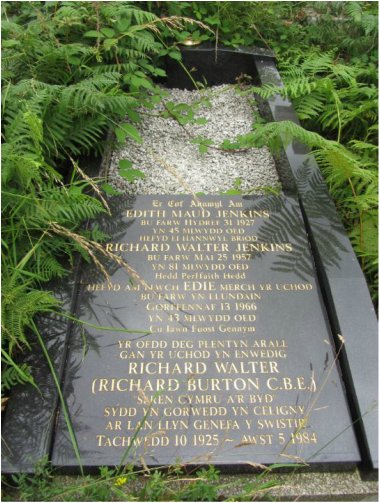
Unveiled, with great ceremony, on what would have been Richard Burton's eighty-first birthday on November the 10th, 2006, is the Richard Burton Memorial Stone which lies on the grave of his parents and sister in the graveyard of the Jerusalem Chapel located in Pontrhydyfen.
Written in Welsh and highlighted in gold-leaf are the words "Seren Cymru a'r Byd", which translates as "A Star of Wales and the World".
Also commemorated on the stone are his mother and father and one of his sisters, Edie, who had died in 1966.
Richard Burton's mother, Edith Maud (nee Thomas) was born in Llangyfelach, just outside Swansea, on the 28th of January, 1883, and died aged just forty-five on October the 31st, 1927, just six days after giving birth to her thirteenth child, Richard Burton's younger brother Graham.
Richard Burton's father, Richard Walter Jenkins Senior, affectionately known as Dic and also Daddy Ni, was born on the 5th of March 1876 in Efail-Fach, South Wales, and died on March the 25th 1957 in the Neath General Hospital aged eighty-one.
Sadly the Memorial Stone now lies neglected and unattended, largely forgotten by the local population, as does the now dilapidated Jerusalem Chapel, which once stood proud and magnificent, overlooking the village.
Written in Welsh and highlighted in gold-leaf are the words "Seren Cymru a'r Byd", which translates as "A Star of Wales and the World".
Also commemorated on the stone are his mother and father and one of his sisters, Edie, who had died in 1966.
Richard Burton's mother, Edith Maud (nee Thomas) was born in Llangyfelach, just outside Swansea, on the 28th of January, 1883, and died aged just forty-five on October the 31st, 1927, just six days after giving birth to her thirteenth child, Richard Burton's younger brother Graham.
Richard Burton's father, Richard Walter Jenkins Senior, affectionately known as Dic and also Daddy Ni, was born on the 5th of March 1876 in Efail-Fach, South Wales, and died on March the 25th 1957 in the Neath General Hospital aged eighty-one.
Sadly the Memorial Stone now lies neglected and unattended, largely forgotten by the local population, as does the now dilapidated Jerusalem Chapel, which once stood proud and magnificent, overlooking the village.
The frontage of the Jerusalem Chapel, Pontrhydyfen the location of the burial plots of Richard Burton's parents and sister Edie and now home to the Richard Burton Memorial Stone, unveiled in November, 2006.
Bethel Chapel, Pontrhydfen
The now, sadly dilapidated, once magnificent Bethel Chapel, located across the Y Bont Fawr bridge, Pontrhydyfen. it was here on the 11th of August, 1984 that the Pontrhydyfen Memorial Service for the life of Richard Burton took place.
Port Talbot and Taibach Photograph Album
Talbot Memorial Park
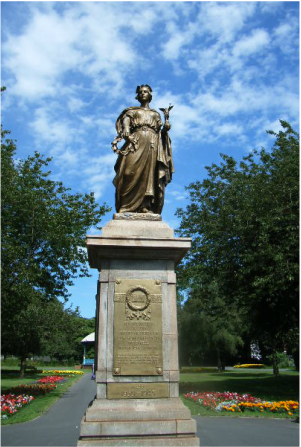
Although Richard Burton will forever be associated with Pontrhydyfen, mainly due to his own nostalgic stories, the truth is he was in fact a Port Talbot boy, living in the town from the age of two years old until he left South Wales for good, in the pursuit of stardom, at the age of twenty-one.
Naturally, he often returned to Pontrhydyfen in order to visit his father and brothers and sisters, but it was in fact in Taibach in which he was schooled and was influenced by and Taibach was the town that moulded him to become the man he grew up to be. Without Taibach, and the influential characters who were fated to be involved in the formative years of Richard Jenkins, the world may never have heard of Richard Burton.
Located in the very heart of Taibach is the Talbot Memorial Park, a landmark Richard Jenkins would be all too familiar with, probably passing through every day. The family home in Caradoc Street is only a short distance away and the Eastern Primary School he attended backs onto the park in the far corner. Another reason he would know the park well is that the Taibach Rugby field and Rugby club run alongside the perimeter.
The park was landscaped in 1925 and is still to this day beautifully maintained. Also incorporated in the park is a contemporary bandstand and War Memorial. Visitors are greeted to the park by a stunning gateway dedicated to Rupert Price Hallows, VC. The land on which the park is situated was donated by the Margam Estate in 1925 and the park was formally opened on the 26th of June, 1926.
Naturally, he often returned to Pontrhydyfen in order to visit his father and brothers and sisters, but it was in fact in Taibach in which he was schooled and was influenced by and Taibach was the town that moulded him to become the man he grew up to be. Without Taibach, and the influential characters who were fated to be involved in the formative years of Richard Jenkins, the world may never have heard of Richard Burton.
Located in the very heart of Taibach is the Talbot Memorial Park, a landmark Richard Jenkins would be all too familiar with, probably passing through every day. The family home in Caradoc Street is only a short distance away and the Eastern Primary School he attended backs onto the park in the far corner. Another reason he would know the park well is that the Taibach Rugby field and Rugby club run alongside the perimeter.
The park was landscaped in 1925 and is still to this day beautifully maintained. Also incorporated in the park is a contemporary bandstand and War Memorial. Visitors are greeted to the park by a stunning gateway dedicated to Rupert Price Hallows, VC. The land on which the park is situated was donated by the Margam Estate in 1925 and the park was formally opened on the 26th of June, 1926.
73 Caradoc Street, Taibach
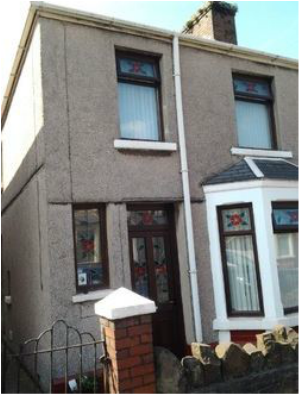
Following the death of their mother, Edith Jenkins, on the 31st of October, 1927, the youngest members of the family were taken to live with their older siblings at addresses located in different parts of South Wales. On the 4th of November, shortly before his second birthday, the young Richard Jenkins was taken to live with his sister Cecilia, who was twenty-two at the time and living in a small rented property in an area of Taibach known as 'The Constant Bungalows', with her twenty-five year old husband, Elfed James.
!n 1929 Elfed was able to place a deposit on this address, 73 Caradoc Street, a new three-bedroomed, semi-detached house which was to be their first proper marital home. Although at the time the house had no electricity, just mains gas, it did have a modern indoor bathroom and for the first time Richard Jenkins had his own bedroom, the small box room upstairs at the front of the house. Richard Jenkins was to remain at this address until the 1st of March, 1943, the date on which he moved to Philip Burton's lodging house, a short distance away in Connaught Street.
It was just a short walk from this address in Caradoc Street to the local Co-Operative store where Cecilia would do her weekly shopping and the place where the teenaged Richard Jenkins would later find his first employment. On the way she would pass a small bakers shop, on the corner of Commercial Road, which was owned by the Hopkins family. It was in the upstairs flat of this bakers shop in 1937 that the Welsh actor, Anthony Hopkins was born.
My gratitude goes to Ryan and Charlotte for their kind permission to use a photograph of their house on the Richard Burton Museum Website.
!n 1929 Elfed was able to place a deposit on this address, 73 Caradoc Street, a new three-bedroomed, semi-detached house which was to be their first proper marital home. Although at the time the house had no electricity, just mains gas, it did have a modern indoor bathroom and for the first time Richard Jenkins had his own bedroom, the small box room upstairs at the front of the house. Richard Jenkins was to remain at this address until the 1st of March, 1943, the date on which he moved to Philip Burton's lodging house, a short distance away in Connaught Street.
It was just a short walk from this address in Caradoc Street to the local Co-Operative store where Cecilia would do her weekly shopping and the place where the teenaged Richard Jenkins would later find his first employment. On the way she would pass a small bakers shop, on the corner of Commercial Road, which was owned by the Hopkins family. It was in the upstairs flat of this bakers shop in 1937 that the Welsh actor, Anthony Hopkins was born.
My gratitude goes to Ryan and Charlotte for their kind permission to use a photograph of their house on the Richard Burton Museum Website.
Port Talbot Eastern Primary School
The Port Talbot Eastern Primary School which Richard Jenkins attended until he was eight years old.
The stunning view of the Mynydd Margam mountain which a young Richard Jenkins would have viewed from the classroom window of the Port Talbot Eastern Primary School. A few years later, under the tutelage of his foster father Philip Burton, he would climb the long slope to the summit and recite passages from Shakespeare. This was, firstly to improve his elocution and pronunciation of the English language and secondly, to strengthen his voice to aid projection in readiness for the theatre. Richard Burton in later years would recall...
"It sounds terribly romantic and idiotic, but in actual fact I would go to the top of the mountain and scream as loudly as I could until my voice hurt. Then when it hurt, I waited for a bit and then screamed again to fix it some way so that it didn't hurt. It was a very primitive way of doing it, but it worked..."
"It sounds terribly romantic and idiotic, but in actual fact I would go to the top of the mountain and scream as loudly as I could until my voice hurt. Then when it hurt, I waited for a bit and then screamed again to fix it some way so that it didn't hurt. It was a very primitive way of doing it, but it worked..."
The Taibach Co-Operative Wholesale Society
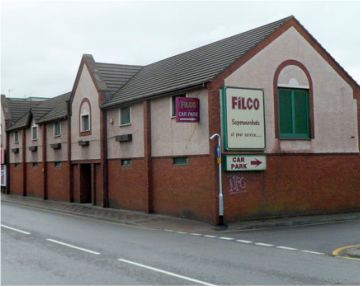
Now a branch of the Welsh supermarket chain Filco, this is the building that was once home, in the 1940's, to the Taibach Co-Operative Wholesale Society.
This Co-Operative style of retail business was fairly unique to Britain at that time. In essence it meant that the store was owned by the local customers, therefore meaning the customers were the shareholders with the profits divided up at the end of the year, in what was to become known as the 'Divi'. This style of retail practice ensured the Co-Operative of a regular supply of loyal customers.
It was here in this building, from April the 4th, 1941 and for the next ten months that Richard Jenkins was forced to become a draper's assistant in the men's outfitting department.
It was Elfed James, Cis's husband, who had demanded that Richard should leave school and start bringing home a weekly pay-packet, and Elfed was easily able to secure him employment there as his own father was on the Co-Operative committee. As a mature Richard Burton was later to comment...
" I was humiliated. It was not the kind of work a miner's son should be doing. I hated it".
This was all too apparent during the ten months he was to be employed there. Richard Jenkins neither showed any interest or enthusiasm for the job, probably hoping that his employers would sense this and dismiss him of their own will. One part of the job entailed the delivery of goods to customers using the store bicycle. According to co-workers at the time, the bicycle was usually spotted leaning against the wall of one of the many local pubs in the area.
It was only thanks to the intervention of one of his schoolmasters, Meredith Jones, that Richard Jenkins was able to leave the world of regular employment for good and finally return to the Secondary School in Port Talbot to finish his education.
This Co-Operative style of retail business was fairly unique to Britain at that time. In essence it meant that the store was owned by the local customers, therefore meaning the customers were the shareholders with the profits divided up at the end of the year, in what was to become known as the 'Divi'. This style of retail practice ensured the Co-Operative of a regular supply of loyal customers.
It was here in this building, from April the 4th, 1941 and for the next ten months that Richard Jenkins was forced to become a draper's assistant in the men's outfitting department.
It was Elfed James, Cis's husband, who had demanded that Richard should leave school and start bringing home a weekly pay-packet, and Elfed was easily able to secure him employment there as his own father was on the Co-Operative committee. As a mature Richard Burton was later to comment...
" I was humiliated. It was not the kind of work a miner's son should be doing. I hated it".
This was all too apparent during the ten months he was to be employed there. Richard Jenkins neither showed any interest or enthusiasm for the job, probably hoping that his employers would sense this and dismiss him of their own will. One part of the job entailed the delivery of goods to customers using the store bicycle. According to co-workers at the time, the bicycle was usually spotted leaning against the wall of one of the many local pubs in the area.
It was only thanks to the intervention of one of his schoolmasters, Meredith Jones, that Richard Jenkins was able to leave the world of regular employment for good and finally return to the Secondary School in Port Talbot to finish his education.
Smyrna Baptist Chapel
The Noddfa (meaning 'refuge') Welsh Congregational Chapel, which is now renamed Smyra Baptist Chapel, was the chosen place of worship to be attended by a young Richard Jenkins by his sister Cecilia and her husband Elfed James from 1939 onwards.
The Noddfa Welsh Congregational Chapel was founded after a split from the Gibeon Chapel in 1933. (The Gibeon Chapel is still located in Gallipoli Terrace in the town). The Jenkins family had loyally followed the minister, the Reverend Dr. John Caerau Rees, to the Noddfa Chapel. The Noddfa first held their services in the Taibach library and later the Memorial Hall before this building, located on Commercial Road, Taibach was built especially in 1939. The foundation stones, written in both Welsh and English, can be seen below the windows and confirm the date as April the 20th, 1939.
The Noddfa Chapel would appear often in the childhood diary entries of Richard Jenkins for the year 1940, and it would appear that he spent most of his Sunday mornings, afternoons and evenings there that year.
One such entry, written on December the 15th of 1940 reads...
"I was made a member today and I drank my first drop of wine and ate my first lump of bread".
The Noddfa Welsh Congregational Chapel was founded after a split from the Gibeon Chapel in 1933. (The Gibeon Chapel is still located in Gallipoli Terrace in the town). The Jenkins family had loyally followed the minister, the Reverend Dr. John Caerau Rees, to the Noddfa Chapel. The Noddfa first held their services in the Taibach library and later the Memorial Hall before this building, located on Commercial Road, Taibach was built especially in 1939. The foundation stones, written in both Welsh and English, can be seen below the windows and confirm the date as April the 20th, 1939.
The Noddfa Chapel would appear often in the childhood diary entries of Richard Jenkins for the year 1940, and it would appear that he spent most of his Sunday mornings, afternoons and evenings there that year.
One such entry, written on December the 15th of 1940 reads...
"I was made a member today and I drank my first drop of wine and ate my first lump of bread".
Philip Burton's Lodging House, Connaught Street, Taibach
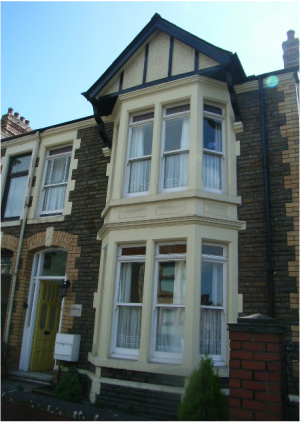
Philip Burton's former lodging house, as it looks today.
This grand Edwardian house, located at 6, Connaught Street, Taibach, was previously owned by a widow named Mrs. Elizabeth Smith, known locally as 'Ma Smith', whose husband, employed as a maritime engineer, had died of the widespread flu epidemic which had hit South Wales hard in 1917.
A deceptively large Edwardian building, with a downstairs kitchen, three living rooms and four large bedrooms, it was at this address that Philip Burton resided during his years spent teaching English at the Port Talbot School.
Philip Burton was the occupier of the second largest bedroom, (the largest belonged to Mrs. Smith and her two daughters, Liz and Audrey), and also had the privilege of being allocated the sole use of one of the three living rooms in the property.
At the time of Philip Burton's arrival at Connaught Street there were two other permanent occupants, a bank clerk and an engineer.
The young Richard Jenkins moved to this address from his former home in Caradoc Street on St. David's Day, March the 1st, 1943, taking over the vacant room which had recently been made available due to the bank clerk being called up for his National Service, and it was here that he would remain, being tutored by his former English master and foster father, for the next two and a half years before he left his beloved South Wales for the bright lights and fame waiting for him in London.
This grand Edwardian house, located at 6, Connaught Street, Taibach, was previously owned by a widow named Mrs. Elizabeth Smith, known locally as 'Ma Smith', whose husband, employed as a maritime engineer, had died of the widespread flu epidemic which had hit South Wales hard in 1917.
A deceptively large Edwardian building, with a downstairs kitchen, three living rooms and four large bedrooms, it was at this address that Philip Burton resided during his years spent teaching English at the Port Talbot School.
Philip Burton was the occupier of the second largest bedroom, (the largest belonged to Mrs. Smith and her two daughters, Liz and Audrey), and also had the privilege of being allocated the sole use of one of the three living rooms in the property.
At the time of Philip Burton's arrival at Connaught Street there were two other permanent occupants, a bank clerk and an engineer.
The young Richard Jenkins moved to this address from his former home in Caradoc Street on St. David's Day, March the 1st, 1943, taking over the vacant room which had recently been made available due to the bank clerk being called up for his National Service, and it was here that he would remain, being tutored by his former English master and foster father, for the next two and a half years before he left his beloved South Wales for the bright lights and fame waiting for him in London.
This page was updated on the 11th of November, 2020
